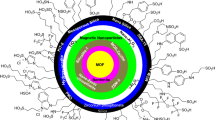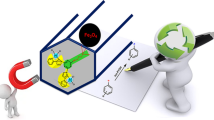Abstract
The role of o-bisguanidinobenzenes (BGBs) as new Brønsted base ligands for arsenic and phosphoric acids was examined. In solution state, complexation was evaluated by Job’s plot in 1H NMR experiment, indicating a 1:1 complex formation, whereas in solid state crystalline structures of complexes obtained were addressed by X-ray crystallographic analysis and/or solid state 13C NMR experiment, in which 1:2 complexes between the BGB and the acid components were normally formed. Based on these results, Merrifield and Hypogel® resin-anchored BGBs were designed and prepared as the corresponding polymer-supported host ligands. Evaluation of their coordination ability with metal salts (ZnCl2 and CoCl2) and arsenic acid in aqueous media by ICP-MS showed that the latter Hypogel® resin-anchored BGBs acted as effective immobilized base ligands.
Similar content being viewed by others
Abbreviations
- RT:
-
Room temperature
- THF:
-
Tetrahydrofuran
- DMF:
-
Dimethylformamide
References
Staab HA, Saupe T (1988) “Proton Sponges” and the geometry of hydrogen bonds: aromatic nitrogen bases with exceptional basicities. Angew Chem Int Ed Engl 27: 865–879. doi:10.1002/anie.198808653
Alder RW (1989) Strain effects on amine basicities. Chem Rev 89: 1215–1223. doi:10.1021/cr00095a015
Alder RW (1990) Intrabrigehead chemistry. Tetrahedron 46: 683–713. doi:10.1016/S0040-4020(01)81354-5
Llamas-Saiz AL, Foces-Foces C, Elguero J (1994) Proton sponges. J Mol Struct 328: 297–323. doi:10.1016/0022-2860(94)08367-3
Raczyńska ED, Decouzon M, Gal J-F, Maria P-C, Gelbard G, Vielfaure-Joly F (2001) Gas-phase structural (internal) effects in strong organic nitrogen bases. J Phys Org Chem 14: 25–34. doi:10.1002/1099-1395(200101)14:1<25::AID-POC332>3.0.CO;2-E
Ishikawa T, Kumamoto T (2006) Guanidines in organic synthesis. Synthesis, 737–752. doi:10.1055/s-2006-926325
Kovačević B, Maksić ZB (2002) The proton affinity of the superbase 1,8-bis(tetramethylguanidino)naphthalene (tmgn) and some related compounds: a theoretical study. Chem Eur J 8: 1694–1702. doi:10.1002/1521-3765(20020402)8:7<1694::AID-CHEM1694>3.0.CO;2-D
Kawahata M, Yamaguchi K, Ishikawa T (2005) o-Bisguanidinobenzene, a powerful hydrogen acceptor: crystal structures of organic complexes with benzoic acid, phenol, and benzyl alcohol. Cryst Growth Des 5: 373–377. doi:10.1021/cg049864c
Kawahata M, Shikii K, Seki H, Ishikawa T, Yamaguchi K (2006) Absolute ordered cluster formation of an o-bisguanidinobenzene–benzoic acid complexes. Chem Pharm Bull (Tokyo) 54: 147–148. doi:10.1248/cpb.54.147
Suda K, Saito N, Kumamoto T, Nakanishi W, Kawahata M, Yamaguchi K, Ogura Y, Suzuki KT, Ishikawa T (2009) Semi-quantitative approaches to the coordination ability of o-bisguanidiniobenzenes with metal salts. Heterocycles 77: 375–387. doi:10.3987/COM-08-S(F)27
Peters A, Wild U, Hübner O, Kaifer E, Himmel H-J (2008) Mono- and diprotonation of the superbasic bisguanidine 1,2-bis(N, N, N′, N′-tetramethylguanidino)benzene (btmgb) and PtII and PtIV complexes of chelating bisguanidines and guanidinates. Chem Eur J 14: 7813–7821. doi:10.1002/chem.200800244
Kawahata M, Yamaguchi K, Ito T, Ishikawa T (2006) 2,2′-o-Phenylenebis(1,3-dimethylguanidine). Acta Crystallogr E62: o3301–o3302
Bissen M, Frimmel FH (2003) Arsenic—a review. Part I: occurrence, toxicity, speciation, mobility. Acta Hydrochim Hydrobiol 31: 9–18. doi:10.1002/aheh.200390025
Bissen M, Frimmel FH (2003) Arsenic—a review. Part II: oxidation of arsenic and its removal in water treatment. Acta Hydrochim Hydrobiol 31: 97–107. doi:10.1002/aheh.200300485
Meharg A (2005) Venomous earth: how arsenic caused the world’s worst mass poisoning. Macmillan, NY, USA
Short PL (2007) Keeping it clean: the chemical industry is finding ways to secure and expand global water supplies. Chem Eng News 23: 13–20
Sato N, Kuriyama H, Agoh M. (1987) 2-(4-Pyridylaminomethyl)-benzimidazole derivatives having antiviral activity. EP0252507A1
Hashimoto T (1960) Synthesis of organosilicon compounds. VI. On the bromination and nitration of m-trimethylsilylacetanilinde. Yakugaku Zasshi 80: 730–733
Nasielski-Hinkens R, Levêque P, Castelet D, Nasielski J (1987) The four 6-halo-7-nitroquinoxalines. Heterocycles 26: 2433–2442. doi:10.3987/R-1987-09-2433
Isobe T, Ishikawa T (2001) Modified guanidines as potential chiral superbases. 1. Preparation of 1,3-disubstituted 2-iminoimidazolidines and the related guanidines through chloroamidine derivatives. J Org Chem 99: 7770–7773
Ohno K, Ishida W, Kamata K, Oda K, Machida M (2003) Synthesis of 2-dimethylaminobenzazoles via a guanidine intermediate: reaction of 2-substituted aniline derivatives with 2-chloro-1,1,3,3-tetramethylformamidinium chloride. Heterocycles 59: 317–322. doi:10.3987/COM-02-S39
Hirose K (2001) A practical guide for the determination of binding constants. J Incl Phenom 39: 193–209. doi:10.1023/A:1011117412693
Dietrich B, Fyles DL, Fyles TM, Lehn J-M (1979) Anion coordination chemistry: polyguanidinium salts as anion complexones. Helv Chim Acta 62: 2763–2787. doi:10.1002/hlca.19790620827
Gross R, Dürner G, Göbel MW (1994) Beschleunigung von Substitutionsreaktionen eines Phosphorsäurediesters durch Bis(guanidinium)—Verbindungen. Libigs Ann Chem, pp 49–58
Tobey SL, Anslyn EV (2003) Energetics of phosphate binding to ammonium and guanidinium containing metallo-receptors in water. J Am Chem Soc 125: 14807–14815. doi:10.1021/ja030507k
Raczyńska ED, Cyrański MK, Gutowski M, Rak J, Gal J-F, Maria P-C, Darowska M, Duczmal K (2003) Consequences of proton transfer in guanidine. J Phys Org Chem 16:91–106. and references cited therein. doi:10.1002/poc.578
Wilkinson HS, Harrison WTA (2005) Guanidinium dihydrogenarsenate. Acta Crystallogr E61: m2023–m2025
Drozd M, Baran J, Pietraszko A (2005) Diguanidinium hydrogenarsenate monohydrate and its deuterated analogue: vibrational, DSC and X-ray investigations. Spectrochim Acta [A] 61: 2809–2821. doi:10.1016/j.saa.2004.10.027
Schaefer J, Stejskal EO (1976) Carbon-13 nuclear magnetic resonance of polymers spinning at the magic angle. J Am Chem Soc 98: 1031–1032. doi:10.1021/ja00420a036
Author information
Authors and Affiliations
Corresponding author
Rights and permissions
About this article
Cite this article
Ito, T., Suda, K., Kumamoto, T. et al. Complexability of o-bisguanidinobenzenes with arsenic and phosphoric acids in solution and solid states, and the potential use of their immobilized derivatives as solid base ligands for metal salts and arsenic acid. Mol Divers 14, 131–145 (2010). https://doi.org/10.1007/s11030-009-9155-7
Received:
Accepted:
Published:
Issue Date:
DOI: https://doi.org/10.1007/s11030-009-9155-7




